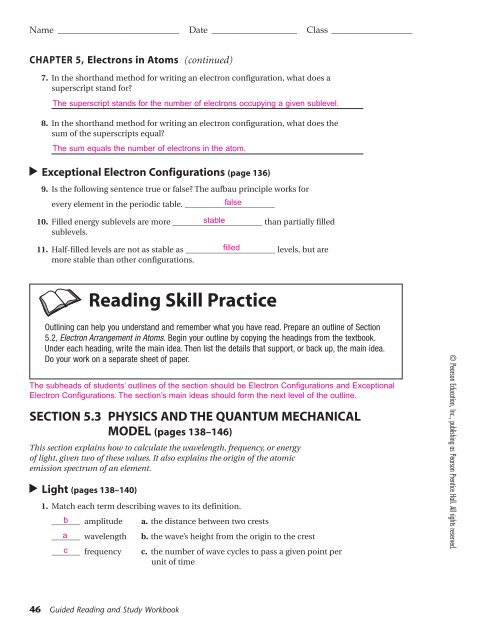KEY-FinalExamStudyGuide_Fall2013
KEY-FinalExamStudyGuide_Fall2013
KEY-FinalExamStudyGuide_Fall2013
You also want an ePaper? Increase the reach of your titles
YUMPU automatically turns print PDFs into web optimized ePapers that Google loves.
Name ___________________________ Date ___________________ Class __________________<br />
CHAPTER 5, Electrons in Atoms (continued)<br />
7. In the shorthand method for writing an electron configuration, what does a<br />
superscript stand for?<br />
The superscript stands for the number of electrons occupying a given sublevel.<br />
8. In the shorthand method for writing an electron configuration, what does the<br />
sum of the superscripts equal?<br />
The sum equals the number of electrons in the atom.<br />
Exceptional Electron Configurations (page 136)<br />
9. Is the following sentence true or false? The aufbau principle works for<br />
every element in the periodic table. ______________________<br />
false<br />
10. Filled energy sublevels are more ______________________ stable<br />
than partially filled<br />
sublevels.<br />
11. Half-filled levels are not as stable as ______________________ filled<br />
levels, but are<br />
more stable than other configurations.<br />
Reading Skill Practice<br />
Outlining can help you understand and remember what you have read. Prepare an outline of Section<br />
5.2, Electron Arrangement in Atoms. Begin your outline by copying the headings from the textbook.<br />
Under each heading, write the main idea. Then list the details that support, or back up, the main idea.<br />
Do your work on a separate sheet of paper.<br />
The subheads of students’ outlines of the section should be Electron Configurations and Exceptional<br />
Electron Configurations. The section’s main ideas should form the next level of the outline.<br />
SECTION 5.3 PHYSICS AND THE QUANTUM MECHANICAL<br />
MODEL (pages 138–146)<br />
This section explains how to calculate the wavelength, frequency, or energy<br />
of light, given two of these values. It also explains the origin of the atomic<br />
emission spectrum of an element.<br />
Light (pages 138–140)<br />
1. Match each term describing waves to its definition.<br />
_______ b amplitude a. the distance between two crests<br />
_______ a wavelength b. the wave’s height from the origin to the crest<br />
_______ c frequency c. the number of wave cycles to pass a given point per<br />
unit of time<br />
© Pearson Education, Inc., publishing as Pearson Prentice Hall. All rights reserved.<br />
46 Guided Reading and Study Workbook


